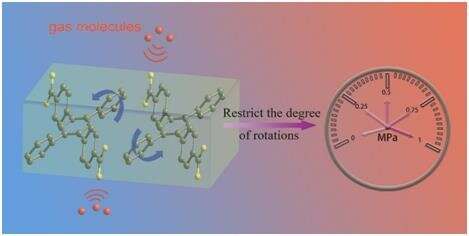Researchers realize gas-pressure-dependent luminescence

Photoluminescent metal-organic frameworks (PL-MOFs) have emerged as a promising class of stimuli-responsive luminescent materials due to their wide range of optoelectronic applications, particularly in luminescence sensing.
In recent years, a few studies have shown that the luminescence of MOFs can respond to pressure stimulus. Nevertheless, luminescence response in subtle-to-low pressure regimes, which requires higher sensitivity of pressure-responsive materials, has not been realized in PL-MOFs heretofore.
Recently, a research group led by Prof. Hong Maochun from the Fujian Institute of Research on the Structure of Matter of the Chinese Academy of Sciences reported the gas pressure-dependent luminescence from an AIEgen-based metal-organic framework.
The study was published in Nature Communications on April 19.
Aggregation-induced emission (AIE) refers to the phenomenon that organic luminescent groups exhibit higher photoluminescence efficiency in the aggregated state than in solution, and the restriction of intramolecular motions (RIM) is the main reason for the generation of AIE.
Anchoring AIE chromophores within MOFs not only provides a platform for further understanding the mechanism of AIE but also offers opportunities to explore attractive optical properties in new matrices.
By introducing a new AIE luminogen (AIEgen) as the ligand, the researchers got an AIEgen-based MOF named FJI-H31. In FJI-H31, the intramolecular motions of the AIE group can be reversibly fine-tuned by gas molecules, leading to a remarkable and continuous variation in luminescence intensity and finally realizing the first gas-pressure-responsive photoluminescent MOF.
They first synthesized FJI-H31(Gd) by using ligand with Gd3+, and the luminescence intensity of FJI-H31(Gd) was enhanced gradually with the enhancement of nitrogen gas pressure with a good linear relationship.
They then filled different gases (carbon dioxide, argon, and air) step by step around the FJI-H31(Gd), and the fluorescence intensity showed a linear enhancement gradually with the enhancement of gas pressure.
Besides, FJI-H31(GdxEu1-x) obtained by introducing different ratios of Eu3+ ions had a dual-emission center luminescence of ligand and Eu3+ ions, and the fluorescence intensity of the dual-emission centers showed a gradual enhancement with the increase of gas pressure. "The dual-emission luminescence MOF enriches the luminescence color and improves the accuracy of detection," said Prof. Hong.
More information: Zhijia Li et al, Achieving gas pressure-dependent luminescence from an AIEgen-based metal-organic framework, Nature Communications (2022). DOI: 10.1038/s41467-022-29737-z
Journal information: Nature Communications
Provided by Chinese Academy of Sciences





















